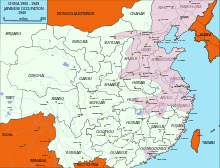Free China (Second Sino-Japanese War)
The term Free China, in the context of the Second Sino-Japanese War, refers to those areas of China not under the control of the Imperial Japanese Army or any of its puppet governments, such as Manchukuo, the Mengjiang government in Suiyuan and Chahar, or the Provisional Government of the Republic of China in Peiping (now Beijing). The term came into more frequent use after the Battle of Nanjing, when Chiang Kai-shek evacuated the government of the Republic of China to Chungking (now Chongqing).
| Free China | |||||||
|---|---|---|---|---|---|---|---|
 The extent of Japanese control of China as of 1940. The area in white constitutes "Free China". | |||||||
| Traditional Chinese | 中華民國自由地區 | ||||||
| Simplified Chinese | 中华民国自由地区 | ||||||
| Literal meaning | Free Area of the Republic of China (full form used only occasionally) | ||||||
| |||||||
History
In the final days of the Battle of Nanking, the Republic of China's National Revolutionary Army helped to evacuate the Chiang Kai-shek government to Chongqing, which was declared the provisional capital of the Republic of China. The Japanese, following their victory at Nanking (now Nanjing), created yet another puppet government, the Reformed Government of the Republic of China, which was later merged with the Provisional Government of the Republic of China to create the Wang Jingwei Government. Many civilians from Japanese-controlled areas of China fled to Free China.
Conflict between the Communists and Nationalists continued in the area of Free China, the most severe example being the New Fourth Army Incident. At the same time, Japanese action against the Communists and Nationalists continued; Chongqing was bombed 268 times, making it the most-bombed city in all of World War II, and, even as late as December 1944, the Japanese Operation Ichigo succeeded in taking control of Guangxi, giving them a continuous railway link between Manchukuo and Southeast Asia. The Japanese also prepared to invade Sichuan in an attempt to destroy the regime in Chongqing and take ultimate control of mainland China; however, they were forced to surrender before this plan had succeeded.
The term "Free area of the Republic of China" was later reused by the Nationalist government after their retreat to Taiwan to contrast their territory with that of the People's Republic of China.
Bibliography
- Linebarger, Anthony; Paul Myron (1941). The China of Chiang Kai-shek: A Political Study. World Peace Foundation.
- Ride, Edwin. BAAG: Hong Kong Resistance 1942-1945. United Kingdom: Oxford University Press. See chapter 2, "Escape to Free China".
- Yu, Patrick Shuk-Siu (2000). A Seventh Child and the Law. Hong Kong: Hong Kong University Press.